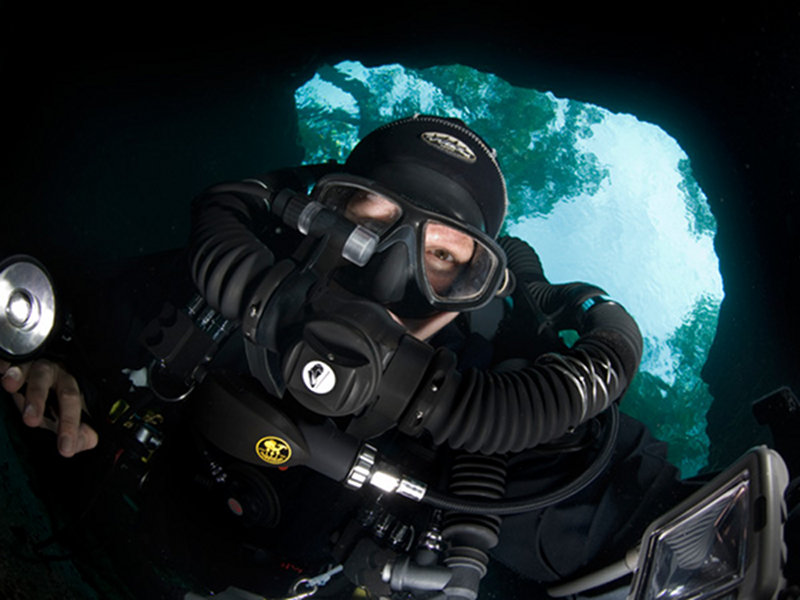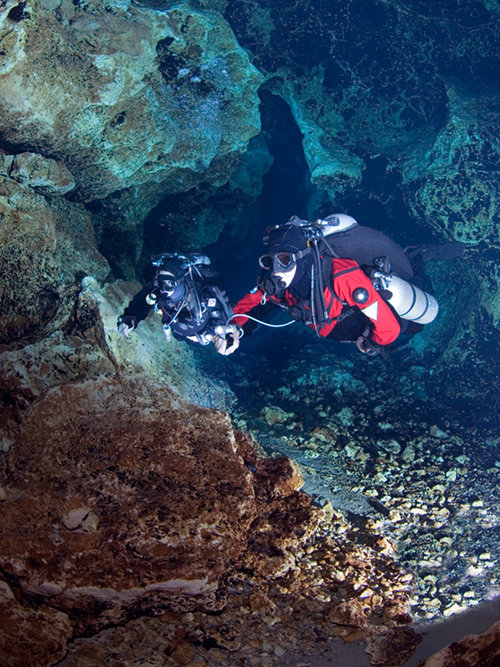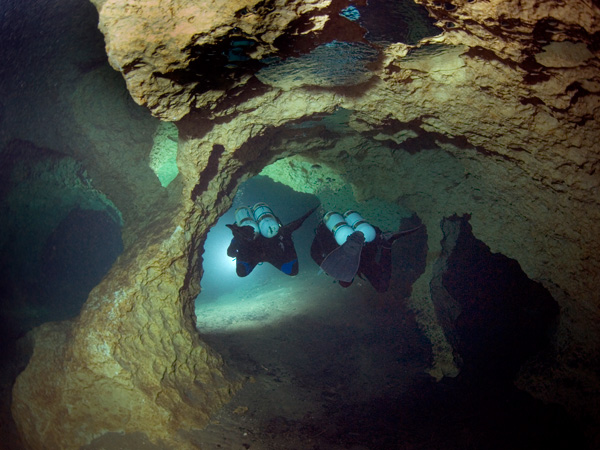
By Jill Heinerth, Underwater Videographer - www.IntoThePlanet.com

Jill Heinerth snaps a self portrait using her rebreather. Image courtesy of Jill Heinerth, Bermuda Deep Water Caves 2011 Exploration, NOAA-OER. Download larger version (jpg, 4.2 MB).
Rebreather diving is not a new concept. In fact, rebreathers were available long before traditional open circuit scuba equipment. Open circuit divers carry high-pressure cylinders mounted on buoyancy control devices (BCD) with some type of harness system. Regulators attached to the tanks lower the pressure of the supply gas so that it can be delivered to the diver on demand as they inhale. As the diver exhales, the resulting bubbles are vented directly into the water column. Since humans only use a very small portion of the oxygen molecules in an inhaled breath for metabolism, they exhale vital leftovers resulting in very inefficient system.
A rebreather on the other hand, takes advantage of the exhaled bubbles by recapturing them, scrubbing them clean of carbon dioxide and returning them to the diver with the addition of extra oxygen to maintain an appropriate level for metabolism. The first rebreathers in the late 1800s were pure oxygen rebreathers. They could only be used at very shallow depths, but allowed much longer, bubble-free operation for divers.
As interest grew in rebreathers and applications demanded deeper units, a solution called “semi-closed circuit rebreathers” was developed. Semi-closed circuit rebreathers still create some bubbles. They inject a steady stream of oxygen enriched air or other mixed gas into a set of breathing bags. As the diver’s exhaled breath is recaptured in the system, a few bubbles are vented off and fresh gas is injected to make up the difference. The equipment is carefully calibrated so that the injection stream makes up the correct volume of oxygen lost through bubbles and diver metabolism. Semi-closed circuit rebreathers gave divers a better duration from their gas cylinders and longer no-decompression times over standard air diving, but still had the disadvantage of venting gas in the form of bubbles.

Two divers using traditional back mounted open circuit scuba equipment to explore a cave. Image courtesy of Jill Heinerth, Bermuda Deep Water Caves 2011 Exploration, NOAA-OER. Download larger version (jpg, 4.6 MB).
Fully closed-circuit rebreathers (CCRs) offer the greatest advantage over standard scuba. A fully closed-circuit rebreather only vents gas on ascent. It has the greatest degree of gas savings and nets divers the longest no-decompression times. Some CCRs are capable of run times of over 12 hours, regardless of depth. They can be up to 200 times more efficient than standard open-circuit scuba. CCRs are now developing into true life-support devices that better protect the diver from human error and undetected dangers such as carbon dioxide buildup. For example, the Sentinel rebreather from VR Technology brings to the market the first application of an advanced onboard carbon dioxide monitoring system. The three-pronged approach monitors the volume of oxygen that passes through the solenoid valve estimating the production of carbon dioxide, tracks the thermal profile of the reaction zone within the bed of scrubber material and monitors gaseous carbon dioxide within the breathing loop using infrared technology, netting a reasonable expectation of scrubber life as well as detecting errors in preparation of the scrubber or failures of the system.

Two divers using traditional back mounted open circuit scuba equipment to explore a cave. Image courtesy of Jill Heinerth, Bermuda Deep Water Caves 2011 Exploration, NOAA-OER. Download larger version (jpg, 7.8 MB).
Although rebreathers have been used for a long time in military applications and some commercial work, they are relatively new to the consumer market. Currently photographers, scientists, cave explorers and even recreational divers use them. Some technical diving organizations have recently sanctioned beginner’s diving courses so that people interested in the underwater world may launch their education on rebreathers and never have to use standard open circuit equipment. Other major agencies like the Professional Association of Diving Instructors (PADI), are fully embracing the technology with plans to launch an entire series of recreational and technical programs this year. It appears that rebreathers will be a big part of the future of recreational diving as well as the tool of choice for deep explorers.